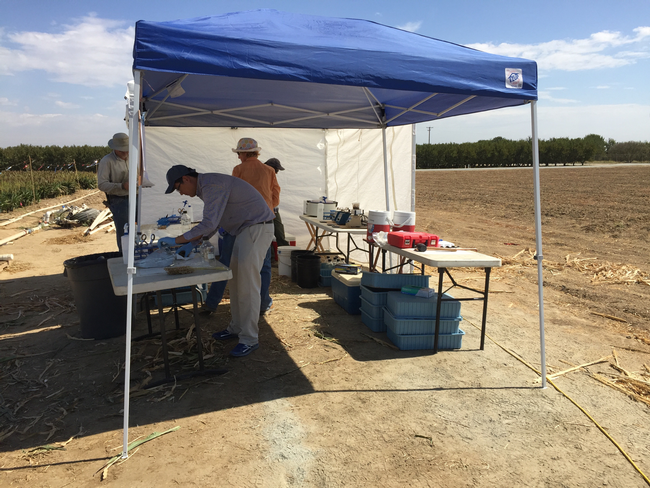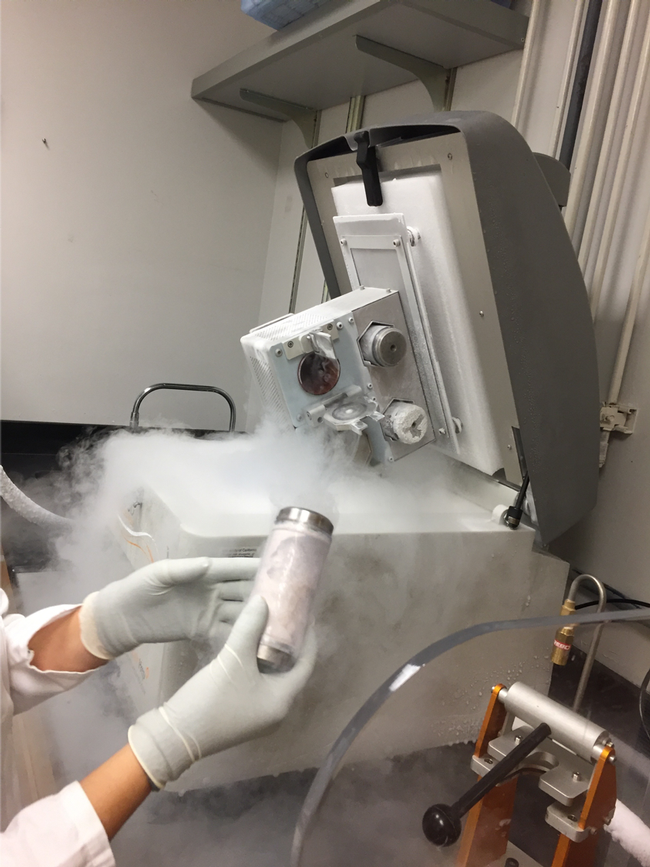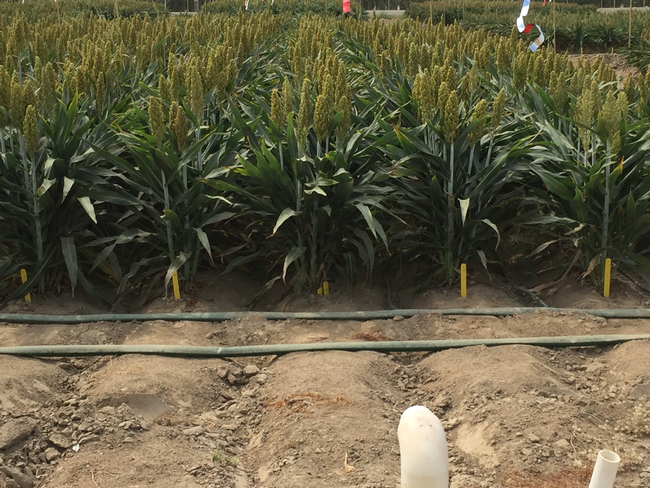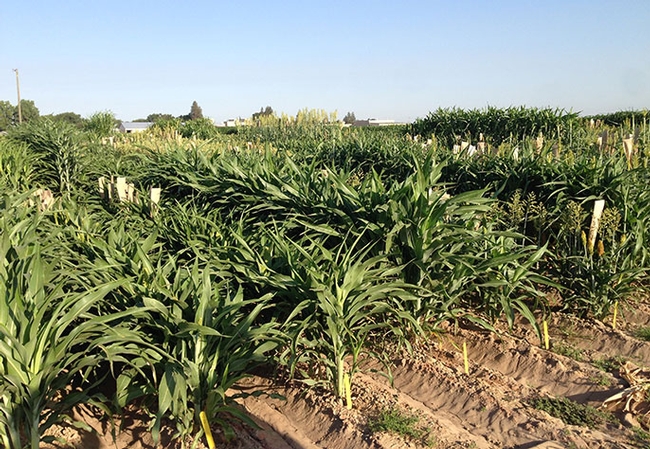Posts Tagged: sorghum
Genomic gymnastics help sorghum plant survive drought
Scorching temperatures and parched earth are no match for the sorghum plant — this cereal crop, native to Africa, will remain green and productive, even under conditions that would render other plants brown, brittle and barren.
A new study published this week in the journal Proceedings of the National Academy of Sciences provides the first detailed look at how the plant exercises exquisite control over its genome — switching some genes on and some genes off at the first sign of water scarcity, and again when water returns — to survive when its surroundings turn harsh and arid.
“With this research, we are laying the groundwork for understanding drought tolerance in cereal crops,” said Jeff Dahlberg, UC Cooperative Extension sorghum specialist. Dahlberg, co-author of the study, is also director the UC Kearney Agricultural Research and Extension Center in Parlier, one of nine research and extension centers in California that are part of UC Agriculture and Natural Resources.
Dahlberg said researchers can use the knowledge gained from this project to search for drought genes in other cereal crops.
“That has implications for feeding the world, particularly considering changing climate and weather patterns,” he said.
The massive dataset, collected from 400 samples of sorghum plants grown during 17 weeks at Kearney, reveals that the plant modulates the expression of a total of 10,727 genes, or more than 40% of its genome, in response to drought stress. Many of these changes occur within a week of the plant missing a weekly watering or after it is first watered after weeks of no precipitation or irrigation.
Kearney is a 330-acre agriculture research facility in the heart of California's Central Valley, where field-scale, real-world research can be conducted on drought impact on plants and soil microbial communities. The climate is naturally dry throughout the summer, making it ideal to mimic drought conditions by withholding irrigation water.
“People have really shied away from doing these types of experiments in the field and instead conduct them under controlled conditions in the laboratory or greenhouse. But I believe that the investment of time and resources that we put into it is going to pay off, in terms of the quality of the answers that we get, in terms of understanding real-world drought situations,” said Peggy Lemaux, UC Cooperative Extension specialist in UC Berkeley's Department of Plant and Microbial Biology and co-author of the paper.
To conduct the research, the team cultivated sorghum plants under three different irrigation conditions — pre-flowering drought, post-flowering drought and controlled applications of water — over three consecutive years at Kearney.
Each week during the growing season, members of the research team carefully harvested samples from the leaves and roots of selected plants and set up a mobile lab in the field where they could rapidly freeze the samples until they were processed for analysis. Then, researchers at JGI sequenced the RNA in each sample to create the transcriptome data, which reveals which of the plant's tens of thousands of genes are being transcribed and used to make proteins at particular times.
Finally, statisticians led by UC Berkeley statistics professor Elizabeth Purdom parsed the massive transcriptome data set to pinpoint how gene expression changed as the plants grew and were subjected to drought or relief from drought conditions.
“We very carefully controlled the watering conditions, and we sampled over the entire developmental timeframe of sorghum, so [researchers] could actually use this data not only to study drought stress, but also to study plant development,” Lemaux said.
The researchers noticed a few interesting patterns in the transcriptome data. First, they found that a set of genes known to help the plant foster symbiotic relationships with a type of fungus that lives around its roots was switched off in drought conditions. This set of genes exhibited the most dramatic changes in gene activity that they observed.
“That was interesting, because it hinted that the plants were turning off these associations [with fungi] when they were dry,” said John Vogel, a staff scientist at JGI and co-author of the paper. “That meshed well with findings that showed that the abundance of these fungi around the roots was decreasing at the same time.”
Second, they noticed that certain genes known to be involved with photosynthesis were also turned off in response to drought and turned up during drought recovery. While the team doesn't yet know why these changes might help the plant, they provide interesting clues for follow-up.
The data in the current paper show the plant's transcriptome under both normal conditions and drought conditions over the course of a single growing season. In the future, the team also plans to publish data from the other two years of the experiment, as well as proteomic and metabolomic data.
Nelle Varoquaux and Cheng Gao of UC Berkeley and Benjamin Cole of JGI are co-first-authors of the study. Other co-authors include Grady Pierroz, Christopher R. Baker, Dhruv Patel, Mary Madera, Tim Jeffers, Judith A. Owiti, Stephanie DeGraaf, Ling Xu, Krishna K. Niyogi, Devin Coleman-Derr and John W. Taylor of UC Berkeley; Joy Hollingsworth, Julie Sievert and Jeffery Dahlberg of UC ANR KARE; Yuko Yoshinaga, Vasanth R. Singan, Matthew J. Blow, Axel Visel and Ronan O'Malley of JGI; Maria J. Harrison of the Boyce Thompson Institute; Christer Jansson of PNNL and Robert Hutmacher of UC ANR.
This research was funded in part by the Department of Energy (DOE) grant DE-SC001408; the Gordon and Betty Moore Foundation grant GBMF3834; the Alfred P. Sloan Foundation grant
2013-10-27; L'Ecole NormaleSupérieure-Capital Fund Management data science chair and the DOE's Office of Biological and Environmental Research grant DE-SC0012460. Work conducted by the DOE JointGenome Institute is supported by the Office of Science of the DOE contractDE-AC02-05CH11231.
RELATED INFORMATION
- Dealing with Drought: Uncovering Sorghum's Secrets
- Berkeley to lead $12.3M study of crop drought tolerance
- Drought treatment restructures plants' microbiomes
- Microbes associated with plant roots could be a key to helping plants survive drought
UC research could help farmers face droughts worldwide
Sorghum is not only a potential drought-tolerant crop for the San Joaquin Valley, it also presents the opportunity for scientists to understand the mechanism behind drought tolerance at the genetic level, said UCCE sorghum specialist Jeff Dahlberg in a segment on ABC 30 Action News.
Reporter Cristina Davies spent an hour and a half at the UC Kearney Agricultural Research and Extension Center in Parlier during the sorghum harvest to learn about the potential of sorghum research.
"If we can elucidate the genetics behind (drought tolerance), what we believe is we can use those genetics to see if the genetics are available in corn, or in rice, or in wheat," Dahlberg said. "I think the genes may be there. We just don't have the tools yet to search for the genes in those crops."
Conducting drought-tolerance research in California is ideal because the summer is typically devoid of rain. Researchers can control exactly how much water is applied to each sorghum plot. The research has revealed more than 100 genetic markers that may confer drought tolerance.
"We've been really thrilled with the data that's been coming out of this. Like most research, we are learning so many things we don't understand," Dahlberg said.
The research is being conducted in collaboration with the USDA's Agricultural Research Service research center, which is across the street from Kearney. USDA research scientist Devin Coleman-Derr was present for the sorghum harvest.
"Like humans take probiotics, there may be a use for microbes in sort of promoting better and better yields in the field," Coleman-Derr said.
The 330-acre UC Kearney Agricultural Research and Extension Center is the University of California's largest off-campus agricultural research facility.
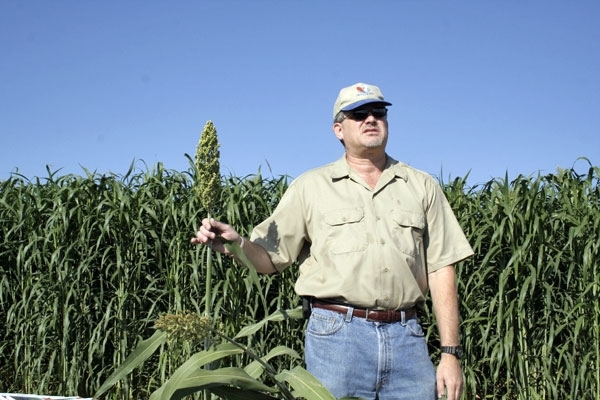
UCCE specialist Jeff Dahlberg studies sorghum at the UC Kearney Agricultural Research and Extension Center in Parlier.
Sugarcane Aphid - an Unwelcome Visitor to California's Central Valley
Sorghum is grown in California as a high yielding, drought resistant, low input forage and grain crop. However, it's been bugged lately. Last...
Microbes associated with plant roots could be a key to helping plants survive drought
As sorghum plants cope with drought conditions, the plants' roots and adjoining microbial communities are communicating in a chemical language that appears to improve the plants' chances under water stress.
“It's amazing,” said Peggy Lemaux, UC Cooperative Extension specialist. “We know there are lots of microbes in the soil and, for the most part, ones in the surrounding soil stayed the same under drought conditions. We only saw changes in those microbes closely associated with the roots.”
The role of drought in restructuring the root microbiome was the first published discovery to come out of a sweeping drought research project underway since 2015 in the fields at UC Kearney Research and Extension Center in Parlier. The five-year study, funded with a $12.3 million grant from the Department of Energy, aims to tease out the genetics of drought tolerance in sorghum and its associated microbes. Using sorghum as a model, scientists hope the research will help them understand and improve drought tolerance in other crops as well.
The new research results from the lab of USDA's Devin Coleman-Derr at UC Berkeley, published April 16, 2018, in the Proceedings of the National Academy of Sciences, document the fate of microbes associated with sorghum roots under three distinct irrigation regimens. Because the San Joaquin Valley generally sees no rain during the growing season, it is the ideal place to mimic drought conditions by withholding irrigation water.
All plots received a pre-plant irrigation to initiate growth. In the control plots, sorghum was irrigated normally, with weekly watering through the season. In the plot simulating pre-flowering drought stress, the plants received no additional water until flowering, about halfway through the season. The third treatment was watered normally until it flowered, and then water was cut off for the rest of the season.
Beginning when the plants emerged, the scientists collected samples from each plot on the same day and time each week for 17 weeks. In a mini, in-field laboratory, roots, rhizosphere (zone surrounding the root), leaves and soil samples from 10 plants in each plot were immediately frozen and transported to Berkeley, where they were disseminated to collaborators, who investigated the plant and microbial responses at the molecular level.
“When a sorghum plant is subjected to drought, it starts sloughing off metabolites, nutrients and amino acids from the roots. The compounds appear to communicate to the neighboring microbial community that the plant is under stress,” Lemaux said. “That selects out a certain population of microbes. Certain types of microbes increase, others go away. When you add water back, the microbial community returns to its pre-drought population in just a few days.”
The researchers cultured two specific microbes that were enriched in the rootzone under drought conditions. They coated sorghum seeds with the microbes and planted them under drought conditions in a growth chamber. This treatment encouraged the plant to grow more roots.
“The microbes appear to improve plant growth during drought,” Lemaux said. “Those microbes appear to be helping plants survive drought. We didn't know that was happening before we got these results.”
Lemaux said the research might lead to future field use of the research breakthrough.
“A lot of companies are interested in the microbiome,” she said. “Some are already selling microbes to coat seeds.”
2017 Kearney Alfalfa and Forage Field Day Presentations Now Available On-Line
As the alfalfa hay harvest season wraps up and we get in gear to attend the November 2017 Western Alfalfa and Forage Symposium in Reno, NV, we're...


